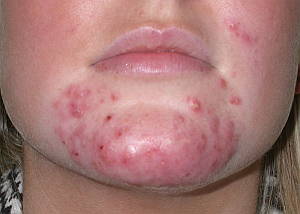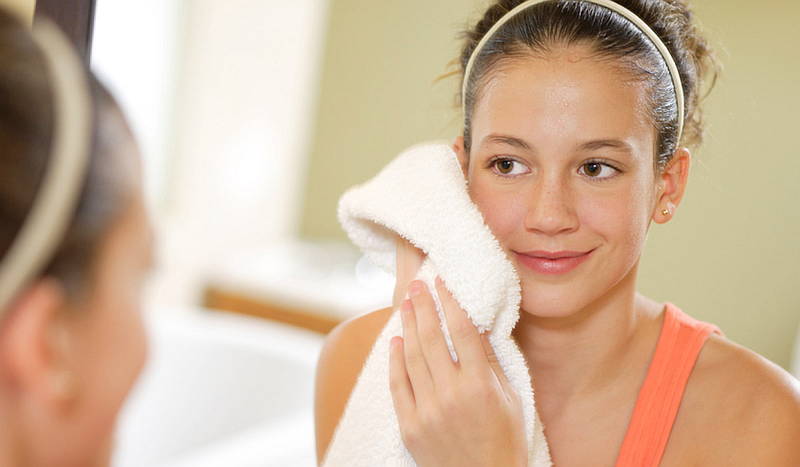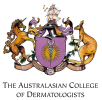Acne vulgaris mainly affects people in their teenage years and early twenties, with a small proportion of people experiencing the condition throughout their adult life. Acne is often seen on the forehead, chin, cheeks, nose and also on the back, chest and neck. In most people, acne does not leave permanent scarring. However, people who get large, very inflamed acne lesions are more likely to develop scarring than those with mild-moderate acne. The onset of acne is earlier for girls than it is for boys. However, it is more likely for boys to experience severe cases of acne. Acne has a number of important psychosocial effects. Sufferers are often very self-conscious of their acne and can experience low self-esteem. Acne can also lead to scarring, which can also have negative effects on self-esteem.
Causes
Acne vulgaris is the result of abnormally functioning sebaceous (oil) glands and the closely related hair follicles in the skin. The glands make an oily substance called sebum, which helps to lubricate the skin and protect it from water. The amount of sebum produced by the sebaceous glands increases dramatically during puberty. This is the main reason why adolescents are predominantly affected by acne. Another mechanism is the increased adhesiveness of the keratinocytes at the skin surface, with reduced sloughing. The sebum and keratin from the hair and skin can block the hair follicle and its pore, causing a small cyst to form. Bacteria (Propionibacterium acnes) may also colonise the cyst. The cyst becomes inflamed, resulting in the typical features seen on the skin as a result of acne.
Acne severity is also closely related to hormone production. Some babies may have a form of acne in the first few weeks of life. This has been related to the high levels of hormones which circulate during pregnancy, and will resolve once the hormones have stabilised. In females, there is an association between the menstrual cycle and breakouts of acne. There are several changes in the hormones in the average 28-day menstrual cycle:
- The levels of the female hormones, oestrogen and progesterone fluctuate throughout the menstrual cycle
- The level of testosterone, the male sex hormone that is also found in lower quantities in women, stays fairly constant
- Oestrogen levels are highest in the first 14 days of the cycle
- Progesterone levels are highest in the last half of the menstrual cycle
- Just before the start of menstrual bleeding, oestrogen and progesterone levels decrease significantly and stay at a low level during menstruation
So, what do these hormonal changes have to do with acne? The increase in progesterone initially activates the sebaceous glands to make sebum at the mid-way point of the cycle. The sebum clogs up the gland and the hair follicle, and also provides a source of energy for the bacteria. The combination of these changes makes acne worse around the time of menstrual bleeding.
Factors affecting acne severity
 Some people with other medical conditions, such as polycystic ovarian syndrome, have an increased chance of developing more severe acne. This is due to the hormonal effects of this condition. Taking an oral contraceptive pill may be of benefit for sufferers of polycystic ovarian syndrome. Applying oily make-up and some hair products may also aggravate acne in some patients. Wearing hats and the chin straps of helmets can rub against the skin, which may either produce acne or make pre-existing acne worse. Stress and certain medications may also make acne worse. Popping and squeezing your acne does not help, it can flare the acne and increase the risk of scarring. High glycaemic index (GI) foods have been shown to exacerbate acne vulgaris. Although chocolate has not been specifically scientifically proven to cause acne, keeping a healthy, balanced diet may help to clear your skin.
Some people with other medical conditions, such as polycystic ovarian syndrome, have an increased chance of developing more severe acne. This is due to the hormonal effects of this condition. Taking an oral contraceptive pill may be of benefit for sufferers of polycystic ovarian syndrome. Applying oily make-up and some hair products may also aggravate acne in some patients. Wearing hats and the chin straps of helmets can rub against the skin, which may either produce acne or make pre-existing acne worse. Stress and certain medications may also make acne worse. Popping and squeezing your acne does not help, it can flare the acne and increase the risk of scarring. High glycaemic index (GI) foods have been shown to exacerbate acne vulgaris. Although chocolate has not been specifically scientifically proven to cause acne, keeping a healthy, balanced diet may help to clear your skin.
Treatment
Treatment for acne should be directed toward the known causative factors. These include follicular hyperproliferation, excess sebum, Propionibacteriumacnes infection and inflammation. The grade and severity of the acne help in determining which treatments, alone or in combination, are most appropriate.
The current consensus recommends a combination of topical retinoid and antimicrobial therapy as first-line therapy for almost all patients with acne. For specific treatment advice for patients with acne a consultation with a dermatologist is recommended.
If you have any questions or concerns about acne vulgaris contact your local doctor, who will arrange for you to see a dermatologist. Contact us today.



